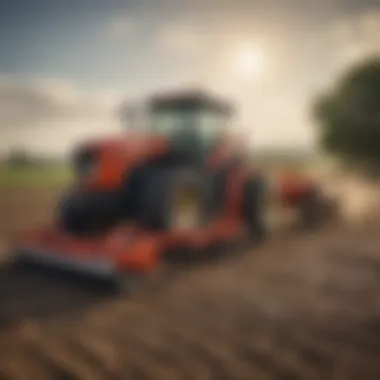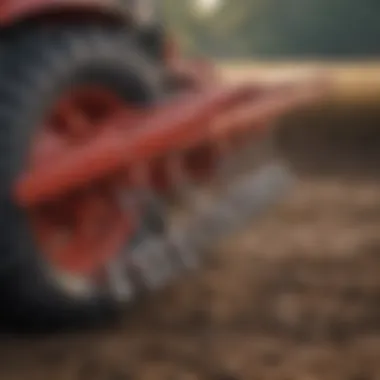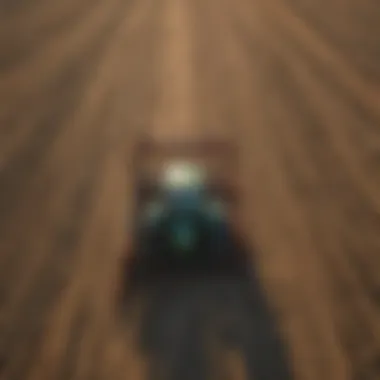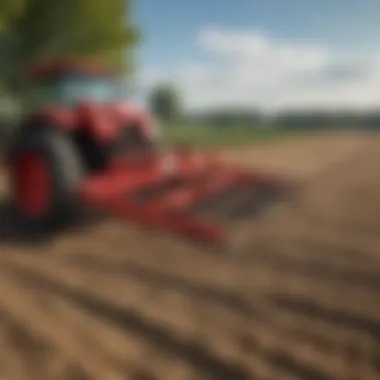Understanding Tractor Drag Rakes in Modern Agriculture


Intro
In modern agriculture, efficiency and precision in land preparation are crucial for maximizing yield and sustainability. Tractor drag rakes are pivotal within this context, serving as versatile tools for soil management, crop preparation, and landscape maintenance. These implements are designed to fulfill specific functions that enhance soil structure, improve seedbed conditions, and contribute to better water retention and nutrient management.
Understanding drag rakes is not simply about knowing their design or how to operate them. It requires an exploration of key concepts that underpin their functionality—this includes terminology that defines their mechanics, the various practices adopted by farmers, and the integration of drag rakes in contemporary tillage systems. A holistic grasp of drag rakes ultimately empowers agricultural practitioners to make informed decisions that align with modern agronomic goals.
Foreword to Tractor Drag Rakes
Tractor drag rakes represent a crucial implementation in present-day agriculture, serving a multitude of functions that promote optimum land utilization. As agriculture evolves, understanding the role and utility of drag rakes becomes essential for farmers and agricultural professionals aiming to enhance productivity. Using tractor drag rakes effectively can lead to significant improvements in soil health, crop yield, and overall farm efficiency. This section will shed light on their defining characteristics and historical significance, setting a foundational understanding for the rest of the article.
Defining Tractor Drag Rakes
Tractor drag rakes are mechanical implements used in agriculture for soil management, particularly to level, spread, and incorporate soil material. These devices are typically attached to the rear of a tractor, utilizing the tractor’s power to perform tasks such as managing crop residue or preparing seedbeds. The design features sturdy frames equipped with flexible teeth that protrude downward, allowing the rake to effectively engage with the soil.
The main function of tractor drag rakes is to assist in land preparation. They help in breaking clumps of soil, thereby increasing the overall soil surface area. This process greatly aids in seedbed preparation, ensuring optimal conditions for planting. Additionally, drag rakes can manage crop debris, making them an integral part of conservation tillage practices. By enhancing soil structure and improving aeration, tractor drag rakes contribute to sustainable farming techniques.
Historical Evolution of Drag Rakes
The concept of drag rakes is not new; it has roots dating back to the early agricultural practices of civilization. Originally, farming tools were simple and made of natural materials. Over time, as farming practices advanced and machinery was developed, tractor drag rakes evolved significantly.
In the early 20th century, the advent of motorized tractors allowed for the mechanization of agriculture. This development prompted improvements in drag rake design, introducing more robust materials and innovative features. Early drag rakes were primarily used to manage soil and crop residue, but modern designs have expanded their functionality, accommodating various soil types and agricultural needs.
The evolution continues as technology advances. Today’s drag rakes may feature hydraulic systems that enable easy adjustments and enhance versatility. This evolution reflects the growing need for efficiency and precision in modern farming.
As we delve deeper into the mechanics and application of tractor drag rakes, it becomes clear that their role in contemporary agriculture is significant. By increasing efficiency in land preparation and gas better results, tractor drag rakes stand as a key instrument in an agricultural professional's toolkit, illustrating their lasting importance in farming.
Mechanics of Tractor Drag Rakes
The mechanics of tractor drag rakes play a crucial role in their operation and effectiveness in modern agriculture. Understanding these mechanics allows farmers and agriculture enthusiasts to optimize their use of drag rakes for various applications. Key components and operational principles define how successfully a drag rake can prepare soil, manage crop residues, and improve overall farm productivity. The efficient functioning of these components ensures that the tool meets the demanding requirements of contemporary agricultural practices.
Components of a Drag Rake
Main Frame
The main frame is the backbone of a tractor drag rake. It supports the entire structure and houses the attachment points for other components. The primary characteristic of the main frame is its robust design, which usually utilizes durable materials like steel or heavy-duty metals. This durability allows the main frame to withstand stress during operation, making it a beneficial choice for high-efficiency farming.
A unique feature of the main frame is its ability to be customized. Many manufacturers offer various sizes and designs to better suit specific field conditions and tractor capabilities. However, choosing a frame that is not well-suited for the intended agricultural environment can lead to decreased functionality and increased wear. Therefore, selecting the right main frame is essential for maximizing the performance of a drag rake.
Rake Teeth
Rake teeth are essential for the functionality of drag rakes. They are designed to penetrate the soil or residue effectively. A key aspect of rake teeth is their geometry, often featuring pointed ends and specific spacing to optimize soil disturbance while minimizing damage to desirable crops. This design makes rake teeth a popular choice for many agricultural tasks, including soil preparation and residue management.
One unique feature of modern rake teeth is their material composition, which often includes hardened steel or wear-resistant alloys. These materials enhance the longevity of the teeth, reducing the frequency of replacements. However, the spacing and size of rake teeth can be a disadvantage if not matched to specific soil types or task requirements. Inappropriate rake teeth can lead to uneven working depth or failure to achieve desired results.
Hitch Mechanism
The hitch mechanism connects the drag rake to the tractor, playing an integral role in how it interacts with the ground. A significant characteristic of the hitch mechanism is its design flexibility, allowing for easy attachment and detachment from various tractor models. This adaptability is particularly beneficial in farms with multiple tractors, allowing one rake to serve different machines without compatibility issues.
The unique feature of newer hitch mechanisms is the use of adjustable settings. This allows the operator to modify the angle and height of the rake, providing a finer control over the rake’s performance. However, complications can arise if the hitch mechanism is not calibrated properly. Incorrect settings can lead to ineffective operation and potential damage to both the tractor and the drag rake.
Operational Principles
Understanding the operational principles of tractor drag rakes is vital for achieving optimal results in agricultural settings. Drag rakes operate based on the principles of mechanics and agronomy, ensuring effective soil management and crop preparation. A drag rake works by being towed behind a tractor, where its rake teeth engage with the soil or crop residue. The movement creates a disturbance that breaks up compacted soil, promotes aeration, and facilitates the even distribution of materials across the field.
The effectiveness of this operation depends greatly on several factors:
- Speed: Optimal travel speed maximizes the interaction between the rake teeth and the soil. Too fast can lead to poor penetration, while too slow can decrease efficiency.
- Weight Distribution: Proper balance assures that the rake maintains consistent ground contact. Uneven weight can lead to incomplete coverage and ineffective results.
- Soil Conditions: Different soil types respond differently to drag raking, making it essential to adjust techniques accordingly.


Types of Tractor Drag Rakes
Understanding the types of tractor drag rakes is fundamental for anyone involved in modern agriculture. Each type serves distinct purposes and offers unique benefits. Making an informed choice based on specific agricultural needs can lead to significant advantages in soil management and crop productivity.
Fixed vs. Adjustable Rakes
Fixed rakes have a set width and arrangement of rake teeth. These rakes are commonly used in simpler applications where flexibility is not a priority. They can effectively level soil and manage debris but may require adjustments when used for different tasks.
Advantages of Fixed Rakes:
- Simplicity in design and operation.
- Generally lower cost compared to adjustable models.
In contrast, adjustable rakes allow for modification of width and angle. This adaptability makes them ideal for various conditions and different types of fields. Farmers can easily maximize efficiency by altering the rake’s settings.
Benefits of Adjustable Rakes:
- Enhanced versatility for diverse agricultural tasks.
- Ability to adapt to environmental changes, improving effectiveness.
Choosing between fixed and adjustable rakes often depends on the specific tasks and the farming operation's scale.
Hydraulic Drag Rakes
Hydraulic drag rakes offer superior control and performance through hydraulic systems. This type is designed for heavy-duty use and is often preferred in larger farming operations. The ability to adjust settings from the tractor cab increases operational efficiency and reduces labor requirements.
Key Features of Hydraulic Drag Rakes:
- Easy adjustment of rake height and angle.
- Increased precision in soil preparation.
Walker Handler drag rakes are a popular choice in this category. Users report enhanced performance, especially in various soil types and conditions. Users must also be aware of hydraulic maintenance to ensure long-lasting operation.
Specialized Drag Rakes for Specific Crops
Specialized drag rakes are tailored for particular types of crops, whether it be row crops like corn or specialty grains. This specificity allows for optimized operation, ensuring that the rake effectively handles the unique requirements of each crop.
Common Types of Specialized Rakes:
- Alfalfa drag rakes for efficient hay management.
- Rice field rakes designed to prevent soil erosion and manage water levels.
Utilizing specialized rakes can lead to better soil health and crop yields. Selecting the right rake based on the crop type and environmental factors is crucial for maximizing agricultural output.
In summary, recognizing the different types of tractor drag rakes and their appropriate applications can significantly impact the success of agricultural practices. Each rake offers various benefits tailored to specific tasks, and understanding these distinctions leads to more effective farming.
"The right choice in drag rake type can enhance both soil management practices and crop productivity."
By making an informed decision, farmers can ensure higher efficiency and better yields in their operations.
Applications in Agriculture
Tractor drag rakes play a crucial role in various agricultural processes. They are not just simple implements; they serve multiple functions that enhance overall efficiency on the farm. Understanding their applications is key to maximizing their benefits.
Soil Preparation and Maintenance
Soil preparation is one of the primary applications of tractor drag rakes. These tools help break up clods of soil, level the surface, and prepare the field for planting. The process also includes removing debris that can hinder seed germination. When farmers use drag rakes, they are able to create a more uniform seedbed. This uniformity ensures that seeds receive adequate soil coverage, moisture, and nutrients. For instance, when used after tillage, a drag rake can effectively smooth the soil surface, making it easier for seed placement.
In terms of maintenance, regular use of drag rakes can improve soil structure over time. They promote even distribution of organic matter and fertilizers, thereby enhancing soil health. Farmers might find that using drag rakes leads to better root development in crops, which can ultimately improve yields.
Effective Crop Residue Management
Managing crop residues is another vital application for tractor drag rakes. After harvesting, crop residues such as stalks and leaves often remain on the field. These residues can be a barrier to new plant growth. A drag rake can assist in breaking down and spreading out these residues effectively. This promotes faster decomposition and integrates them back into the soil, enriching it with organic matter.


Utilizing drag rakes for residue management can also reduce the risk of disease spread among crops. When residues are evenly spread, they tend to dry out faster, reducing pathogens that thrive in damp environments. Moreover, proper crop residue management can enhance soil moisture retention during dry spells, making it a strategic advantage for farmers.
Enhancing Soil Aeration
Soil aeration is essential for healthy crop growth. Tractor drag rakes contribute significantly to this aspect by loosening compacted soil. Compaction can create barriers for root expansion and water infiltration, negatively impacting crop health. By running a drag rake over compacted areas, farmers can create channels in the soil that facilitate better air flow.
With improved aeration, roots can access more oxygen and nutrients, thus increasing plant vigor. Additionally, well-aerated soil retains moisture more effectively, reducing the need for frequent irrigation.
"Proper soil aeration is not just about how well the soil breathes; it is vital for root health and overall crop productivity."
Incorporating tractor drag rakes into regular agricultural practices ensures that farmers are effectively addressing soil preparation, crop residue management, and aeration. Each of these elements contributes significantly to sustainable agriculture, helping to optimize crop yields and soil health.
Advantages of Using Drag Rakes
Tractor drag rakes play a crucial role in modern agriculture, offering numerous benefits that enhance both the efficiency of farming operations and the health of the soil. This section explores the advantages of using drag rakes, focusing on three specific areas: labor and time efficiency, improved soil health and crop yield, and the reduction in erosion and compaction.
Efficiency in Labor and Time
One of the primary advantages of using tractor drag rakes is their ability to significantly improve labor efficiency. These machines enable farmers to cover large areas of land quickly, reducing the time required for soil preparation and maintenance.
- Productivity Boost: Unlike manual or smaller equipment, drag rakes can be towed by tractors, allowing farmers to work larger fields with ease.
- Reduced Labor Costs: With the use of drag rakes, fewer workers are needed to complete the same tasks, which translates into lower overall labor costs.
- Speed of Operation: The design of drag rakes allows for faster operations which means tasks like leveling the soil or managing crop residues can be done more efficiently.
In summary, drag rakes transform labor-intensive processes into more manageable tasks, allowing farmers to allocate resources more effectively.
Improved Soil Health and Crop Yield
Another significant advantage of tractor drag rakes is the positive impact they have on soil health. Healthy soil is vital for enhancing crop yield, and drag rakes contribute to this in several ways:
- Soil Aeration: Drag rakes promote better aeration in the soil, which improves the ability of roots to access water and nutrients.
- Uniform Residue Distribution: By effectively spreading out crop residues, drag rakes prevent the buildup of organic matter in certain areas, leading to a more uniform nutrient distribution across the field.
- Enhanced Microbial Activity: Well-managed soil with proper residue management helps to foster beneficial microbial activity, which is essential for soil fertility.
The combined effects of these factors lead to healthier soil, which, in turn, supports increased and more consistent crop yields.
Reduction in Erosion and Compaction
The utilization of tractor drag rakes also facilitates a reduction in soil erosion and compaction, both of which are critical issues in agriculture.
- Minimizing Erosion: When managing crop residues, drag rakes help protect the topsoil from erosive forces such as wind and water by maintaining a protective layer of organic matter.
- Compaction Management: Due to the way drag rakes distribute soil and residues, they can help reduce soil compaction, which is crucial for maintaining moisture levels and promoting healthier root development.
- Long-Term Benefits: Over time, reducing erosion and compaction leads to sustainable land use and improved agricultural practices.
Best Practices for Using Tractor Drag Rakes
In any agricultural practice, using equipment like tractor drag rakes efficiently is crucial. Best practices for using these tools help in achieving optimal results while minimizing risks and maximizing productivity. Understanding the nuances of working with drag rakes can lead to significant improvements in soil health and crop management.
Pre-Operation Checks
Before beginning any task, it is essential to conduct thorough pre-operation checks of your tractor drag rake. This helps identify any potential issues that may affect performance. Check the following components systematically:
- Rake Teeth Condition: Inspect the rake teeth for wear and damage. Damaged teeth can lead to ineffective raking and may disrupt soil structure.
- Hitch Mechanism: Ensure that the hitch is secure and operating properly. A loose or damaged hitch can cause accidents or reduce maneuverability.
- Fluid Levels: Review hydraulic and other fluid levels. Low fluid levels can hinder operation, especially for hydraulic models.
- Lubrication: Make sure all moving parts are adequately lubricated. This reduces friction and prolongs the life of the equipment.
Taking these steps ensures safety and improves the effectiveness of the drag rake.
Optimal Settings for Different Conditions
Each field condition may require different settings for the drag rake to perform at its best. Factors such as soil type, moisture levels, and crop residue impact how you should adjust the rake. Some recommendations include:
- Soil Type: For sandy soils, use a shallower teeth angle to better agitate the soil without excessive disturbance. Conversely, in clay soils, a more aggressive setting might be necessary.
- Moisture Levels: Wet conditions require careful management to avoid soil compaction. Use lighter pressure on the rake teeth to minimize disturbance.
- Crop Residue: Adjust the rake according to the amount of crop residue present. Increase the aggressiveness to manage heavier residues effectively.
Experimenting with settings and observing results allows for better adaptability to changing conditions.
Post-Operation Maintenance


After completing a raking session, proper maintenance can ensure the longevity of your tractor drag rake. Ignoring maintenance can result in costly repairs and replacements. Key areas to focus on include:
- Cleaning: Remove all debris from the rake. Leftover material can lead to rust and other damage over time.
- Inspection: Conduct a thorough inspection post-operation. Look for any wear and tear, especially on the rake teeth and hitch.
- Storage: Store the drag rake in a dry place to shield it from the elements. A tarp or shed can help protect metal components from moisture.
- Lubrication: Reapply lubricant to moving parts as needed. Regular lubrication keeps parts functioning smoothly and prevents rust.
Following these best practices helps maintain efficiency, prolongs equipment life, and fosters sustainable agricultural practices.
Challenges and Solutions When Using Drag Rakes
In the realm of modern agriculture, tractor drag rakes serve vital functions. However, operators often face various challenges while using these tools. Understanding these common issues and implementing effective solutions is essential for maximizing performance and efficiency in agricultural operations.
Common Operational Problems
When it comes to drag rakes, some operational problems frequently arise. These include:
- Inadequate Depth Control: Farmers often find it challenging to maintain proper rake depth. This issue can lead to uneven soil preparation.
- Clogging of Rake Teeth: Accumulation of debris, such as grass and roots, can hinder raking efficiency.
- Wear and Tear of Components: Over time, parts may wear out, affecting overall operation and effectiveness.
- Poor Hitch Alignment: A misaligned hitch can create steering difficulties, impacting the rake's functionality.
Each of these problems can diminish the efficiency of drag rakes, which directly affects soil management and crop yield.
Mitigation Strategies
Several strategies can be implemented to mitigate these challenges effectively:
- Regular Maintenance: Conducting routine inspections and maintenance on drag rake components can help combat wear and tear. Checking the integrity of the rake teeth and the hitch mechanism is crucial to prolong the lifespan of the equipment.
- Adjustable Depth Settings: Utilizing adjustable settings can enhance depth control. Proper calibration allows for optimal soil engagement based on conditions, leading to more uniform results.
- Clearing Clogs Promptly: Operators should remain vigilant. Addressing clogging as soon as it occurs can maintain operational flow. Keeping tools nearby for quick unclogging may save time.
- Proper Training: Equipping operators with knowledge on correct hitch alignment will contribute to improved efficiency. Ensuring that operators understand the mechanics of their equipment is fundamental for effective use.
Implementing these strategies can significantly reduce operational challenges, leading to enhanced productivity in agricultural practices.
Effective management of drag rakes is paramount to successful crop production and soil health.
Understanding how to navigate these common problems allows farmers to make informed decisions. Efficient use of tractor drag rakes results in better soil management and ultimately contributes to the success of farming operations.
Innovations in Drag Rake Technology
Innovations in drag rake technology have a significant impact on modern agricultural practices. As the demands on agricultural efficiency and sustainability escalate, the development of advanced features in drag rakes has become paramount. Farmers today seek tools that not only perform effectively but also integrate seamlessly with new agricultural advancements. This section will elaborate on the integration of smart technology and the emphasis on sustainability in the design of drag rakes, revealing how these innovations can enhance productivity and minimize environmental impact.
Integration of Smart Technology
The integration of smart technology into drag rake designs represents a fundamental shift in agricultural equipment. Smart technology encompasses various automated systems that allow for improved monitoring and adjustment during operation. These systems can include sensors, GPS, and even machine-learning algorithms.
Smart technology in drag rakes can lead to:
- Precision Control: Automated systems help operators manage settings more effectively, adjusting drag depths and areas covered depending on soil conditions and crop types.
- Data Collection: Utilizing technology allows for real-time data collection regarding soil conditions and rake performance, enabling better decision-making for future operations.
- Remote Monitoring: Farmers can oversee operations from a distance, optimizing workflows without being physically present in the field.
Overall, integrating smart technology provides operational efficiencies and the ability to adapt quickly to changing farming conditions. This can contribute to increased crop yields and reduced labor costs.
Sustainability in Design
The emphasis on sustainability in design is becoming crucial as the agricultural industry faces environmental challenges. Innovations in drag rakes focus on minimizing negative impacts while maximizing utility. Sustainable designs in drag rakes can include:
- Materials: Utilizing recyclable and durable materials reduces waste and extends the lifespan of the equipment.
- Energy Efficiency: New models incorporate features designed to be used with less fuel or energy, lowering the carbon footprint of farming operations.
- Soil Preservation: Modern drag rakes are engineered to minimize soil disturbance while efficiently managing crop residues, promoting healthier soil ecosystems.
Sustainable design not only benefits the environment but also enhances operational efficiency, aligning economic viability with ecological responsibility.
In summary, the innovations in drag rake technology underscore the transformative potential of modern agricultural practices. The combination of smart technology and sustainable design approaches enables farmers to address various challenges while enhancing productivity. By adopting these innovations, agricultural professionals stay competitive and responsive to market demands.
Finale
The role of tractor drag rakes in modern agriculture cannot be understated. These implements are crucial for soil management, contributing to efficiency and effectiveness in the field. They play a significant role in soil preparation through leveling and mixing. This not only supports the formation of a conducive environment for planting but also enhances the overall crop yield.
Summarizing the Importance of Drag Rakes
Tractor drag rakes improve the operational capabilities of farms in various ways. First, their design allows for thorough soil aeration, which is vital for root growth and moisture retention. Additionally, these rakes assist in efficient crop residue management, reducing the need for additional tilling and resulting in lower labor costs. The improved soil health leading to better crop outcomes is also a significant advantage. Drag rakes are easy to operate and maintain, making them accessible for farmers regardless of their level of experience.
Future Trends in Agricultural Machinery
As technology progresses, the future of agricultural machinery, including drag rakes, looks promising. The integration of smart technology will likely enhance the operational precision of drag rakes. Features such as GPS-guided systems and real-time monitoring can offer farmers valuable data insights. Furthermore, innovations in sustainable design aim to reduce the environmental impact of farming practices. The focus will increasingly be on creating machinery that not only boosts productivity but also works in harmony with the ecosystem. As farmers embrace these advancements, we can expect tractor drag rakes to evolve significantly, aligning with both agricultural needs and environmental responsibility.







